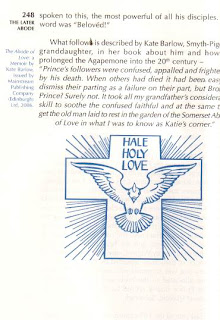Old Men in Love: John Tunnock's Posthumous Papers
 by Alasdair Gray (2007). I bought what is probably Gray's best known novel, Lanark, quite some time ago as the result of considerable chatter around the place. I have yet to read it, however, but when I spotted his latest book, Old Men in Love, on the library shelf I had to pick it up. I'm glad that I have been reading Pope and Swift for my studies this year and read Flann O'Brien a couple of years ago, because this book is very much in their tradition. Indeed, the book has the famous quote from O'Brien's Ar Swim Two Birds about good books needing "three openings entirely dissimilar and interrelated only in the prescience of the author". It also has blurbs from Lawrence Sterne, Samuel Johnson and Sidney Workman ("This book should not be read"). The first two are, of course, fictional but the third has an extra layer of fiction in that Workman is a character from within the pages of Gray's work.
by Alasdair Gray (2007). I bought what is probably Gray's best known novel, Lanark, quite some time ago as the result of considerable chatter around the place. I have yet to read it, however, but when I spotted his latest book, Old Men in Love, on the library shelf I had to pick it up. I'm glad that I have been reading Pope and Swift for my studies this year and read Flann O'Brien a couple of years ago, because this book is very much in their tradition. Indeed, the book has the famous quote from O'Brien's Ar Swim Two Birds about good books needing "three openings entirely dissimilar and interrelated only in the prescience of the author". It also has blurbs from Lawrence Sterne, Samuel Johnson and Sidney Workman ("This book should not be read"). The first two are, of course, fictional but the third has an extra layer of fiction in that Workman is a character from within the pages of Gray's work.As was common with these authors, the book has a somewhat elaborate cover page

although by no means as elaborate as, say, Swift might have employed. It is a layered text - it is ostensibly the papers of one John Tunnock. He was something of a scholar, attempting to write a history of the world. At the same time, he was recording his own life in a diary. After his death, the job was given to one Lady Sara Sim-Jaegar, his next of kin, to wind up his estate. She sells of all his material assets but still had his papers to "embarrass" her:
I had a mass of typescript and a large desktop notebook two-thirds full of undated entries in tiny, clear, almost sinisterly childish calligraphy. It would have been heartless to discard all that as waste paper, but what else could I do? The typed pages were historical novels, which I detest. I also dislike reading diaries, even those written for publication, and a sample of John's miserable confessions made me think them unpublishable - I now know this idea is old-fashioned and out of date.As it happened, one Alistair Gray was available to help her do the impossible: this book is the result of his exertions on her behalf. She has written an introduction ("because his [own] reputation as an occasional writer of fiction often led critics to doubt the value of his serious work") and he has provided the reader with a number of marginal notes
 (not footnotes or endnotes because "I like widening my readers' range of expectations") and a table of contents. There are a number of illustrations, all apparently hand drawn by Gray himself and rather exquisite in their detail
(not footnotes or endnotes because "I like widening my readers' range of expectations") and a table of contents. There are a number of illustrations, all apparently hand drawn by Gray himself and rather exquisite in their detail The introduction raises several questions about Tunnock's mode of living (including whether he ever had sex - he lived with his maiden aunts until they died, just a decade ago) and how he came to die: his diary entries serve to answer those questions and to reveal him as a rather odd man. Here is how it starts:
The introduction raises several questions about Tunnock's mode of living (including whether he ever had sex - he lived with his maiden aunts until they died, just a decade ago) and how he came to die: his diary entries serve to answer those questions and to reveal him as a rather odd man. Here is how it starts: The time is now three in the morning after the most bemusing hours of my life. They started yesterday when I arose and as usual on days when cleaners come, had to start by tidying away signs of female presence scattered over my floors from living room to lavatory: discarded garments, cosmetic tools, photographic magazines about the sex lives of beautiful rich people. The women I once knew kept a tidy house - why are young things who stay here different?He lives a fairly quiet, retired sort of life - spending his days researching and writing in the library, evenings in the pub with some old chums, is described as a "fat wee ugly old man", lives in an extravagantly Victorian house and is himself resolutely old-fashioned yet seems to have some sort of extraordinary appeal to tough young women, women so young that he writes "My fondness for young things could lead to difficulties if Niki is under the age of consent. What is the age of consent? (Memo: find out.)." In between his commentary on these various young things and the ways in which they interrupt his writing, he also muses about more enlightened topics, such as Socrates, his difficulties in understanding Aristophanes' The Clouds...
These diary entries introduce his pieces of writing, pieces he is having published in a local journal as he goes but which may or may not add up to some sort of ultimate world history - they are pretty random. First is a section concerning the war between Sparta and Athens, with a call to arms by Pericles. The next section moves onto Florencethe time Holy Roman Empire, where he has Fra Filippo (Lippi?) arguing about tomatoes and sinning carnally with the nun he was about to paint so he could paint without the distraction of carnal lust.
This theme is picked up, big time, in the third (and longest) section when he pillories a particular Brethren religious sect from England in the 19th century. Henry James Prince is its leader and the account here is taken directly from his journal
 At first, he seems sound: in a nod to Silas Marner, he refuses access to his services to prominent people from the neighbourhood if all they're doing is coming to church for a nap. He wants only those actively engaged in receiving the word and in a Christian life to be there - which seems entirely reasonable to me, but it was not to the powers that be in the Church of England. And so Beloved Brother Prince sets up his own brotherhood - but he is gradually revealed as being an "enthusiast" in the sense described in Dr Johnson's Dictionary i.e. one who has a vain belief in private direct revelation from the Deity. Everything they do is the result of the spirit - a nice justification for doing what he wants. And so his Church becomes rather a vast financial empire in which Beloved Brother Prince is either the second coming of Christ or suffering a blasphemous delusion, depending upon who you listen to. In the same way, he celebrates his ascension by some sort of divine anointing or by raping a 15 year old virgin.
At first, he seems sound: in a nod to Silas Marner, he refuses access to his services to prominent people from the neighbourhood if all they're doing is coming to church for a nap. He wants only those actively engaged in receiving the word and in a Christian life to be there - which seems entirely reasonable to me, but it was not to the powers that be in the Church of England. And so Beloved Brother Prince sets up his own brotherhood - but he is gradually revealed as being an "enthusiast" in the sense described in Dr Johnson's Dictionary i.e. one who has a vain belief in private direct revelation from the Deity. Everything they do is the result of the spirit - a nice justification for doing what he wants. And so his Church becomes rather a vast financial empire in which Beloved Brother Prince is either the second coming of Christ or suffering a blasphemous delusion, depending upon who you listen to. In the same way, he celebrates his ascension by some sort of divine anointing or by raping a 15 year old virgin.Quite how these three pieces work together, I'm not sure. There is a fourth element to the tale, in which Tunnock sets out in his history of the world (starting with the big bang) to make Scotland the logical successor of Greece and Rome. I think that perhaps the key to it all is a poem Tunnock claims to have found as a child which contradicted everything he had ever learnt about history in its portrayal of a grim view of civilization:
This beauty, this Divinity, this thought,and finishes with a reminder that it is dung which keeps the roses sweet.
This hallowed bower and harvest of delight
Whose roots ethereal seemed to clutch the stars,
Whose amaranths perfumed eternity,
Is fixed in earthly soil enriched with bones
Of used up workers; fattened with the blood
Of prostitutes, the prime manure; and dressed
With brains of madmen and the broken hearts
Of children...
The author himself says that he had all these bits he didn't quite know how to join together, and so invented John Tunnock as his device to do so. While there is a lot of fun to be had in reading some parts of the book, and the book itself is a wonderful artefact, the best bits are the tales of Tunnock himself, rather than the pieces he is ostensibly writing. But then Gray pre-empts criticism by having a "review" by Sidney Workman as an epilogue, in which the book is heavily criticised: Henry James said HG Wells made novels by tipping his miind up like a cart and pouring in its contents. At first Old Men in Love seems to have been made in the same haphazard way, but some research in the National Library of Scotland shows it is stuffed with extracts from Gray's earlier writings... These rags of forgotten historical plays fill nineteen chapters. The rest are stuffed with a great deal of half-baked popular science... also political diatribes from pamphlets published before three general elections... Like most Scotsmen Gray thinks himself an authority on Burns, so we find an essay on Burns...
A lot has been written in the press about this book, but I think the account given by the Times Literary Supplement provides the best context for it.


0 Comments:
Post a Comment
Subscribe to Post Comments [Atom]
<< Home